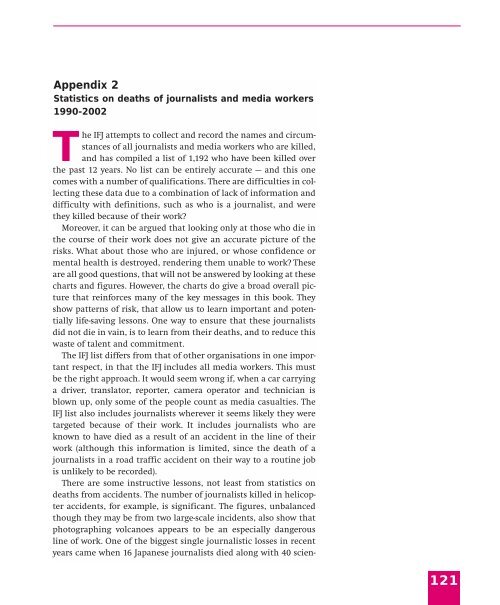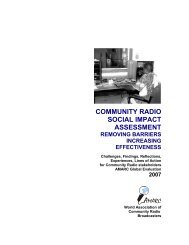Live News - A Survival Guide - International Federation of Journalists
Live News - A Survival Guide - International Federation of Journalists
Live News - A Survival Guide - International Federation of Journalists
- No tags were found...
You also want an ePaper? Increase the reach of your titles
YUMPU automatically turns print PDFs into web optimized ePapers that Google loves.
Appendix 2Statistics on deaths <strong>of</strong> journalists and media workers1990-2002The IFJ attempts to collect and record the names and circumstances<strong>of</strong> all journalists and media workers who are killed,and has compiled a list <strong>of</strong> 1,192 who have been killed overthe past 12 years. No list can be entirely accurate — and this onecomes with a number <strong>of</strong> qualifications. There are difficulties in collectingthese data due to a combination <strong>of</strong> lack <strong>of</strong> information anddifficulty with definitions, such as who is a journalist, and werethey killed because <strong>of</strong> their work?Moreover, it can be argued that looking only at those who die inthe course <strong>of</strong> their work does not give an accurate picture <strong>of</strong> therisks. What about those who are injured, or whose confidence ormental health is destroyed, rendering them unable to work? Theseare all good questions, that will not be answered by looking at thesecharts and figures. However, the charts do give a broad overall picturethat reinforces many <strong>of</strong> the key messages in this book. Theyshow patterns <strong>of</strong> risk, that allow us to learn important and potentiallylife-saving lessons. One way to ensure that these journalistsdid not die in vain, is to learn from their deaths, and to reduce thiswaste <strong>of</strong> talent and commitment.The IFJ list differs from that <strong>of</strong> other organisations in one importantrespect, in that the IFJ includes all media workers. This mustbe the right approach. It would seem wrong if, when a car carryinga driver, translator, reporter, camera operator and technician isblown up, only some <strong>of</strong> the people count as media casualties. TheIFJ list also includes journalists wherever it seems likely they weretargeted because <strong>of</strong> their work. It includes journalists who areknown to have died as a result <strong>of</strong> an accident in the line <strong>of</strong> theirwork (although this information is limited, since the death <strong>of</strong> ajournalists in a road traffic accident on their way to a routine jobis unlikely to be recorded).There are some instructive lessons, not least from statistics ondeaths from accidents. The number <strong>of</strong> journalists killed in helicopteraccidents, for example, is significant. The figures, unbalancedthough they may be from two large-scale incidents, also show thatphotographing volcanoes appears to be an especially dangerousline <strong>of</strong> work. One <strong>of</strong> the biggest single journalistic losses in recentyears came when 16 Japanese journalists died along with 40 scien-121
















